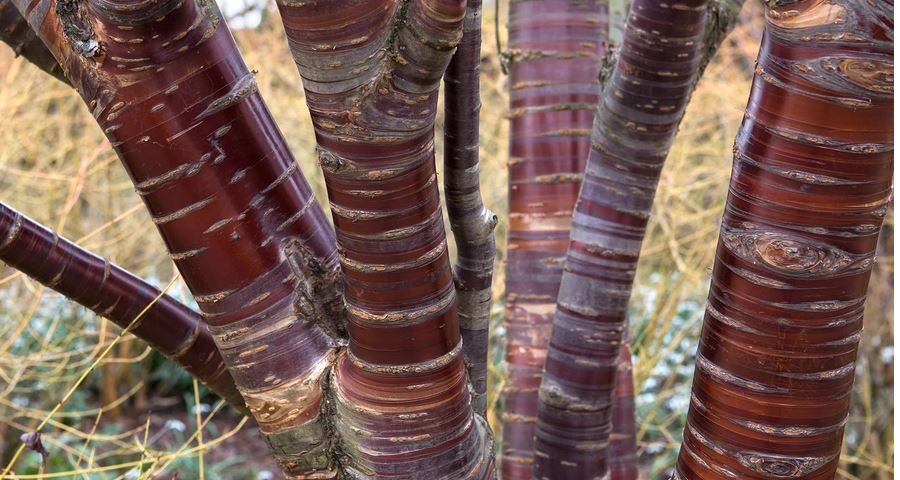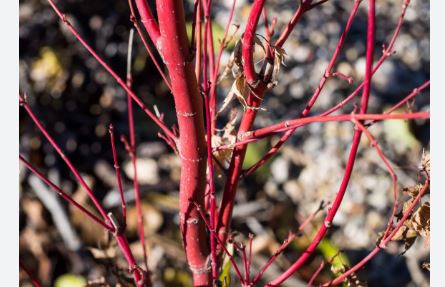
Trees with red bark are prized for their vibrant, eye-catching bark, ranging from bright red to deep reddish-brown or coral hues, often due to natural pigments like tannins. These trees, including both deciduous and evergreen types, enhance landscapes with year-round visual interest, particularly in winter when bark stands out against muted surroundings. Their striking appearance makes them ideal as focal points, hedges, or accents in gardens, adding contrast to green foliage or neutral backdrops. The bark’s texture, whether smooth, peeling, or mottled, further elevates their ornamental value.
These trees thrive across diverse climates, from temperate to warm regions, with many requiring full sun to intensify their bark’s color. Well-drained soil is essential to prevent root issues, though some tolerate wet or dry conditions, suiting varied environments. They range from compact forms for small gardens to larger specimens for expansive landscapes. Selecting varieties that match local conditions ensures vibrant bark and healthy growth with minimal maintenance.
In landscaping, these trees serve as statement pieces, windbreaks, or border plants, with their red bark providing a dramatic effect, especially in colder months. Smaller types fit urban settings or containers, while larger ones are ideal for parks or naturalized areas. Light pruning or coppicing can enhance bark vibrancy, particularly in species with colorful young stems, but heavy cutting should be avoided. Pairing with contrasting foliage or textures creates dynamic garden designs.
Some trees may exhibit a red appearance due to a cosmetic algal film, which forms a red-orange coating but does not penetrate the bark or cause harm. Regular cleaning with warm water can enhance natural bark color and shine, especially for peeling varieties. These trees are low-maintenance, offering ecological benefits like habitat support while adding bold aesthetics to landscapes.

Trees With Red Bark
Paperbark Maple (Acer griseum)
- Description: A small deciduous tree with peeling, cinnamon-red to reddish-brown bark, revealing a vibrant inner layer.
- Uses: Ornamental for gardens; wood used for small decorative items due to its attractive grain.
- Care Tips: Full sun to partial shade, well-drained, moist soil. Hardy in USDA zones 4-8. Slow-growing, needs protection from strong winds.
- Garden Appeal: Grows to 20-30 feet, ideal for small gardens, with brilliant red-orange fall foliage complementing its bark.
Coral-Bark Maple (Acer palmatum ‘Sango-kaku’)
- Description: A small deciduous tree with vivid coral-red bark, most striking in winter, and pale green to yellow leaves.
- Uses: Ornamental for year-round interest; wood occasionally used for small crafts.
- Care Tips: Partial shade, well-drained, fertile soil. Hardy in zones 5-8. Avoid heavy pruning to maintain bark color.
- Garden Appeal: Grows to 15-20 feet, perfect for small landscapes or containers, with vibrant fall colors.
Three-Flowered Maple (Acer triflorum)
- Description: A small deciduous tree with peeling, pale copper-brown to reddish bark, revealing a vibrant underlayer.
- Uses: Ornamental for its bark and fall foliage; wood used in specialty woodworking.
- Care Tips: Full sun, well-drained soil. Hardy in zones 4-8. Slow-growing, low maintenance.
- Garden Appeal: Grows to 20-30 feet, ideal for small gardens, with red-orange fall leaves enhancing its bark.
River Birch (Betula nigra)
- Description: A deciduous tree with peeling, reddish-brown to cinnamon bark, revealing lighter shades beneath.
- Uses: Ornamental for bark texture; wood used for furniture and pulp.
- Care Tips: Full sun to partial shade, moist to wet soil. Hardy in zones 4-9. Tolerates flooding.
- Garden Appeal: Grows to 40-70 feet, ideal for rain gardens or large landscapes, with yellow fall foliage.
Chinese Red Birch (Betula albosinensis var. septentrionalis)
- Description: A deciduous tree with peeling, coppery-pink to cinnamon-red bark, often with golden edges.
- Uses: Ornamental for its stunning bark; wood used for small crafts or fuel.
- Care Tips: Full sun, well-drained soil. Hardy in zones 4-7. Fast-growing, prefers cooler climates.
- Garden Appeal: Grows to 50-80 feet, ideal as a specimen tree in large lawns.
Tibetan Cherry (Prunus serrula)
- Description: A deciduous tree with shiny, red-brown bark that peels in thin, papery strips, glowing in sunlight.
- Uses: Ornamental for its bark; wood occasionally used for small decorative items.
- Care Tips: Full sun, well-drained soil. Hardy in zones 5-8. Clean bark with warm water to enhance shine.
- Garden Appeal: Grows to 20-30 feet, perfect for small gardens, with subtle spring blooms.
Japanese Stewartia (Stewartia pseudocamellia)
- Description: A deciduous tree with peeling, reddish-brown to pinkish bark, creating a mottled effect.
- Uses: Ornamental for four-season interest; wood used in specialty woodworking.
- Care Tips: Full sun to partial shade, moist, well-drained soil. Hardy in zones 5-8. Protect from drought.
- Garden Appeal: Grows to 20-40 feet, ideal for small to medium gardens, with vibrant fall colors.
Pacific Madrone (Arbutus menziesii)
- Description: A broadleaf evergreen with peeling, deep red to reddish-brown bark, revealing smooth green underbark.
- Uses: Ornamental for its bark; wood used for carvings, valued for its hardness.
- Care Tips: Full sun, well-drained, rocky soil. Hardy in zones 7-9. Sensitive to overwatering.
- Garden Appeal: Grows to 40-80 feet, striking in coastal or forest-edge landscapes.
Red-Osier Dogwood (Cornus sericea)
- Description: A deciduous shrub or small tree with bright red bark, most vibrant on young stems in winter.
- Uses: Ornamental for winter interest; stems used in basketry or crafts.
- Care Tips: Full sun to partial shade, moist soil. Hardy in zones 3-8. Coppice annually for vivid bark.
- Garden Appeal: Grows to 6-12 feet, ideal for borders or wetland gardens.
Japanese Red Pine (Pinus densiflora)
- Description: An evergreen conifer with reddish-brown, peeling bark, revealing orange-red underlayers.
- Uses: Ornamental for bark and needles; wood used for construction or pulp.
- Care Tips: Full sun, well-drained soil. Hardy in zones 3-7. Tolerates poor soils.
- Garden Appeal: Grows to 40-60 feet, suitable for small to medium landscapes, with soft green needles.
Dawn Redwood (Metasequoia glyptostroboides)
- Description: A deciduous conifer with reddish-brown, peeling bark in long strips, revealing a rusty tone.
- Uses: Ornamental for its bark and conical shape; wood used for construction.
- Care Tips: Full sun, moist, well-drained soil. Hardy in zones 4-8. Fast-growing.
- Garden Appeal: Grows to 70-100 feet, ideal for large landscapes or parks.
Crape Myrtle (Lagerstroemia indica)
- Description: A deciduous small tree with peeling, cinnamon to reddish-brown bark, creating a mottled effect.
- Uses: Ornamental for bark and summer blooms; wood used for small crafts.
- Care Tips: Full sun, well-drained soil. Hardy in zones 7-9. Prune for bark display.
- Garden Appeal: Grows to 15-25 feet, ideal for small gardens or as a hedge.
Red Bark Eucalyptus (Eucalyptus pauciflora)
- Description: An evergreen with smooth, red to reddish-brown bark with stripes of brown or cream, vibrant in winter.
- Uses: Ornamental for bark; wood used for timber or fuel.
- Care Tips: Full sun, fertile, well-drained soil. Hardy in zones 7-10. Protect from pests like beetles.
- Garden Appeal: Grows to 20-50 feet, striking in Mediterranean or tropical landscapes.
Red Twig Dogwood (Cornus alba ‘Sibirica’)
- Description: A deciduous shrub or small tree with bright red bark on young stems, vivid in winter.
- Uses: Ornamental for winter color; stems used in crafts or arrangements.
- Care Tips: Full sun to partial shade, moist soil. Hardy in zones 2-8. Coppice for best bark color.
- Garden Appeal: Grows to 5-9 feet, ideal for borders or mass plantings.
Coral Bark Willow (Salix alba var. vitellina ‘Britzensis’)
- Description: A deciduous tree with rusty orange to red bark on young stems, glowing in winter.
- Uses: Ornamental for bark; stems used for basketry or crafts.
- Care Tips: Full sun, moist to wet soil. Hardy in zones 2-8. Pollarding enhances bark color.
- Garden Appeal: Grows to 20-30 feet if unpruned, ideal for wet areas or hedges.
Manzanita (Arctostaphylos spp., e.g., A. manzanita)
- Description: A shrub or small evergreen tree with smooth, hard, red to mahogany bark, sometimes peeling in flakes.
- Uses: Ornamental for bark and drought tolerance; wood used for small carvings.
- Care Tips: Full sun, well-drained, dry soil. Hardy in zones 7-9. Avoid overwatering.
- Garden Appeal: Grows to 6-20 feet, ideal for dry, sunny slopes or xeriscapes.
Snakebark Maple (Acer davidii ‘Ernest Wilson’)
- Description: A deciduous tree with green-and-white striped bark, often with reddish undertones, peeling slightly.
- Uses: Ornamental for its unique bark; wood used in small-scale woodworking.
- Care Tips: Full sun to partial shade, moist, well-drained soil. Hardy in zones 5-8.
- Garden Appeal: Grows to 20-40 feet, ideal for medium gardens, with vibrant fall foliage.
Red-Barked Dogwood (Cornus sanguinea ‘Midwinter Fire’)
- Description: A deciduous shrub or small tree with vibrant red-orange to coral bark on young stems, most vivid in winter.
- Uses: Ornamental for winter interest; stems used in crafts or floral arrangements.
- Care Tips: Full sun to partial shade, moist, well-drained soil. Hardy in USDA zones 4-7. Coppice annually to enhance bark color.
- Garden Appeal: Grows to 5-8 feet, ideal for borders, mass plantings, or small gardens.
- Size: 5-8 feet tall, 4-6 feet wide.
Red-Barked Sycamore (Platanus × acerifolia ‘Bloodgood’)
- Description: A deciduous tree with peeling, reddish-brown to mottled red bark, revealing creamy or grayish underlayers.
- Uses: Ornamental for bark and shade; wood used for furniture or crates.
- Care Tips: Full sun, moist, well-drained soil, adaptable to urban conditions. Hardy in zones 4-9.
- Garden Appeal: Grows to 70-100 feet, ideal for large landscapes, parks, or street trees.
- Size: 70-100 feet tall, 50-70 feet wide.
Kousa Dogwood (Cornus kousa)
- Description: A deciduous tree with exfoliating, reddish-brown to tan bark, creating a mottled, patchwork effect.
- Uses: Ornamental for bark, fruit, and foliage; wood used for small crafts.
- Care Tips: Full sun to partial shade, well-drained, fertile soil. Hardy in zones 5-8. Protect from drought.
- Garden Appeal: Grows to 20-30 feet, perfect for small to medium gardens with vibrant fall color.
- Size: 20-30 feet tall, 15-25 feet wide.
Red-Barked Eucalyptus (Eucalyptus gunnii ‘Silver Drop’)
- Description: An evergreen with smooth, reddish-brown to pinkish bark, peeling to reveal silver or cream underlayers.
- Uses: Ornamental for bark and foliage; wood used for timber or fuel.
- Care Tips: Full sun, well-drained soil, drought-tolerant. Hardy in zones 8-10. Prune to maintain juvenile foliage.
- Garden Appeal: Grows to 30-50 feet, ideal for Mediterranean or warm-climate landscapes.
- Size: 30-50 feet tall, 20-30 feet wide.
Tips for Growing Trees with Red Bark
- Climate Matching: Choose trees based on your climate; tropical species like eucalyptus thrive in warm regions, while maples and birches suit cooler zones.
- Sunlight: Most require full sun to enhance bark color; ensure adequate spacing for large species like dawn redwood.
- Soil: Well-drained soil is critical; species like river birch tolerate wet conditions, while manzanita prefers dry soils.
- Landscaping: Use smaller trees (e.g., coral-bark maple) for ornamental gardens and larger ones (e.g., river birch) for shade or wetland areas. Clean peeling bark with warm water to enhance shine.
- Maintenance: Coppicing or pollarding (e.g., dogwoods, willows) enhances bark vibrancy; avoid over-pruning maples. Protect from pests like beetles for eucalyptus.